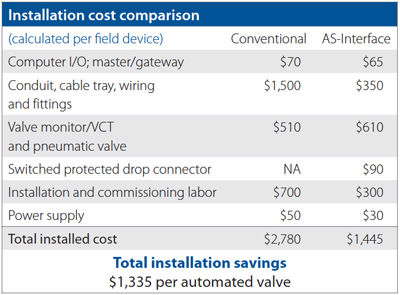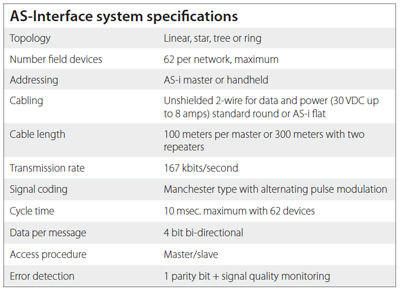AS-Interface
A communications protocol
AS-Interface is considered the ideal protocol for networking discrete automated valves and instruments in the process industries. This easy to install protocol economically networks up to 62 field devices onto a single pair of wires that delivers both signal and power. Interfacing conveniently to most popular PLCs and DCS systems, it may be used in both general purpose and hazardous areas with explosion proofing, nonincendive equipment and nonincendive field wiring protection concepts.

AS-Interface networks up to 62 field devices onto a single pair of wires that delivers both signal and power. Actuator Sensor Interface, or AS-Interface, was developed by a group of sensor manufacturers and introduced into the market in 1994. Since that time, it has become the de facto standard for discrete sensors in process industries throughout the world. AS-Interface may be used in hazardous process environments using explosion proof, tray cable, nonincendive and for nonincendive wiring protection concepts.
- Ideally suited for on/off batch process valves and other discrete applications.
- 62 field devices per network master
- Simple electronics for economical and robust performance.
- Transfer medium is unshielded two-wire cable for both data and power supply.
- Signal transmission has high tolerance to EMI.
- Easy to install providing the greatest cost savings with the least complexity.
- Free choice of network topology allows optimized wiring network.
- Variety of gateways available to seamlessly tie into high level bus network
- Specifications
- AS-Interface products
Using a network with 16 valve communication terminals (VCTs), the following economic analysis may be performed (costs are listed in the amount per automated valve):
There is a net savings of $1,335 per automated valve with AS-Interface communication over the conventional system (52% reduction in installed cost). This savings does not include other cost reductions due to less space consumption for wiring, conduit and I/O racks, as well as greater flexibility in adding field devices or reconfiguring later.

AS-Interface technology has been standardized in EN 50295 and IEC 62026-2. There are over 400 different products available from 50+ vendors. And, as of this writing, there are estimated to be over 12,000,000 installed nodes (field devices) throughout the world.

AS-Interface has continued to improve over the years and has resulted in several versions of the communication protocol. AS-i has been careful to revise the standards to allow for improvements without dversely affecting current users or products/systems that are of older versions. They have made these versions both forward and backward compatible. Here are some of the key differences:
- 2.0-This is the first version of AS-i that had significant usage in the process industries. It featured 31 device and only discrete device profiles were possible (4 bits per device)
- 2.1-This version added the capability for up to 8 bits of discrete I/O and also analog I/O profiles. This version also allowed for optional extended addressing feature (A/B addresses) so that up to 62 devices could be on a single AS-interface network
- 3.0-This version allows for many new device profiles for greater flexibility
- 5.0-This is the latest version. ASi-5 technology significantly increases the performance allowing for advanced diagnostics, making the system future-proof. It has an increased range up to 200 meters with 62 devices on the network. ASi-5 and ASi-3 units can co-exist on a network when used with ASi-5/ASi-3 gateways
- Ideally suited for on/off batch process valves and other discrete applications.
- 62 field devices per network master
- Simple electronics for economical and robust performance.
- Transfer medium is unshielded two-wire cable for both data and power supply.
- Signal transmission has high tolerance to EMI.
- Easy to install providing the greatest cost savings with the least complexity.
- Free choice of network topology allows optimized wiring network.
- Variety of gateways available to seamlessly tie into high level bus network
- Specifications
- AS-Interface products
Using a network with 16 valve communication terminals (VCTs), the following economic analysis may be performed (costs are listed in the amount per automated valve):
There is a net savings of $1,335 per automated valve with AS-Interface communication over the conventional system (52% reduction in installed cost). This savings does not include other cost reductions due to less space consumption for wiring, conduit and I/O racks, as well as greater flexibility in adding field devices or reconfiguring later.

AS-Interface technology has been standardized in EN 50295 and IEC 62026-2. There are over 400 different products available from 50+ vendors. And, as of this writing, there are estimated to be over 12,000,000 installed nodes (field devices) throughout the world.

AS-Interface has continued to improve over the years and has resulted in several versions of the communication protocol. AS-i has been careful to revise the standards to allow for improvements without dversely affecting current users or products/systems that are of older versions. They have made these versions both forward and backward compatible. Here are some of the key differences:
- 2.0-This is the first version of AS-i that had significant usage in the process industries. It featured 31 device and only discrete device profiles were possible (4 bits per device)
- 2.1-This version added the capability for up to 8 bits of discrete I/O and also analog I/O profiles. This version also allowed for optional extended addressing feature (A/B addresses) so that up to 62 devices could be on a single AS-interface network
- 3.0-This version allows for many new device profiles for greater flexibility
- 5.0-This is the latest version. ASi-5 technology significantly increases the performance allowing for advanced diagnostics, making the system future-proof. It has an increased range up to 200 meters with 62 devices on the network. ASi-5 and ASi-3 units can co-exist on a network when used with ASi-5/ASi-3 gateways